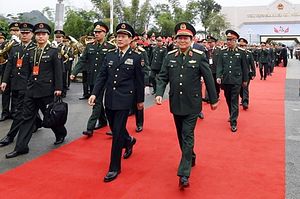This week, the defense ministers of China and Vietnam held a pre-arranged meeting in Hanoi. The meeting highlighted some of the ongoing activity within the military aspect of ties between the two countries in spite of the significant lingering differences they have.
As I have noted previously in these pages, while the relationship between China and Vietnam has long been fraught with challenges – China occupied Vietnam for nearly a millennia, the two countries fought multiple wars, and Hanoi continues to feel the occasional effects of Chinese coercive power even today including in the South China Sea – the two neighboring countries nonetheless continue to manage a wider diplomatic relationship that also includes a defense component. The relationship includes various aspects including visits and exchanges, defense strategy dialogues, joint patrols, and collaboration on party and political work.
That has continued on over the past year or so. Indeed, 2019 was set to see some notable developments with respect to the China-Vietnam relationship, with both sides using the occasion of the 70th anniversary of the establishment of diplomatic ties between the two countries to showcase some positive interactions and Hanoi looking to calibrate its wide range of relationships before it takes up the annually rotating ASEAN chairmanship in 2020 from Thailand this year and also navigates domestic political changes ahead of its next National Party Congress in early 2021.
This week, this aspect of the relationship between China and Vietnam was in focus with a meeting between the defense ministers of the two sides in Hanoi. Chinese Defense Minister Wei Fenghe led a high-ranking defense delegation on an official visit to Vietnam that lasted from May 27 up to May 29, right before making his way to the Shangri-La Dialogue in Singapore where he will address Asia’s premier security summit for the first time in his current capacity.
Wei’s visit to Vietnam included several interactions, including a reception in his delegation’s honor as well as visits to landmarks including Ho Chi Minh’s Mausoleum and the National Defense Academy. But the highlight of the trip was the talks between the two delegations led by him and his Vietnamese counterpart, Ngo Xuan Lich, which were held at Vietnam’s defense ministry. During the meeting, as with previous interactions, both sides discussed a range of issues pertaining to the defense relationship as well as broader domestic, regional, and international affairs of mutual interest.
Per the official account of the talks by Vietnam’s defense ministry, beyond the two sides reviewing the status of implementation of existing defense collaboration, they also agreed to try to foster collaboration in a range of areas that included military medicine, UN peacekeeping operations, and border defense friendship exchanges. There was also mention of the South China Sea, with both sides agreeing to solve disagreements by peaceful means and working to create a peaceful environment there, and Lich also invited Wei to attend the ASEAN Defense Ministers’ Meeting Plus (ADMM-Plus) meetings Vietnam will host next year as well as maritime security drills and an international fleet review there as well.
In addition to this, following the talks, both defense ministers witnessed the signing of cooperation agreements between the agencies of their two ministries, which included a memorandum of understanding on military medical cooperation, an agreement on military staff education, and a memorandum of understanding on military education between Vietnam’s National Defense Academy and China’s Defense University. The Chinese defense ministry also presented a batch of medical and search and rescue equipment to Vietnam’s Defense Ministry.
To be sure, the meeting between the two defense ministers is only one among a series of interactions between both countries, and there will be more of these through the rest of 2019 as well. Nonetheless, such developments will continue to be notable to watch both within the broader Sino-Vietnamese relationship as well as amid wider developments in both countries’ domestic and foreign policies.

































